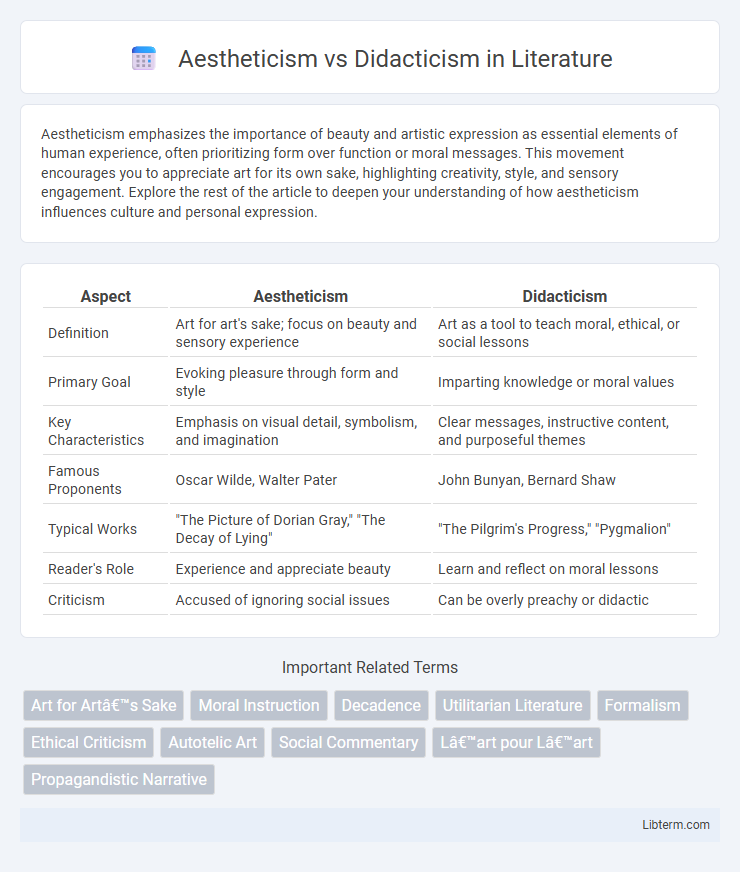Aestheticism emphasizes the importance of beauty and artistic expression as essential elements of human experience, often prioritizing form over function or moral messages. This movement encourages you to appreciate art for its own sake, highlighting creativity, style, and sensory engagement. Explore the rest of the article to deepen your understanding of how aestheticism influences culture and personal expression.
Table of Comparison
| Aspect | Aestheticism | Didacticism |
|---|---|---|
| Definition | Art for art's sake; focus on beauty and sensory experience | Art as a tool to teach moral, ethical, or social lessons |
| Primary Goal | Evoking pleasure through form and style | Imparting knowledge or moral values |
| Key Characteristics | Emphasis on visual detail, symbolism, and imagination | Clear messages, instructive content, and purposeful themes |
| Famous Proponents | Oscar Wilde, Walter Pater | John Bunyan, Bernard Shaw |
| Typical Works | "The Picture of Dorian Gray," "The Decay of Lying" | "The Pilgrim's Progress," "Pygmalion" |
| Reader's Role | Experience and appreciate beauty | Learn and reflect on moral lessons |
| Criticism | Accused of ignoring social issues | Can be overly preachy or didactic |
Introduction to Aestheticism and Didacticism
Aestheticism emphasizes the importance of beauty and sensory experience in art, valuing form and style over moral or instructive content. Didacticism prioritizes teaching and imparting moral, ethical, or educational lessons through artistic expression, often aiming to influence the audience's behavior or beliefs. These contrasting approaches define how literature and art engage with audiences, either by evoking emotional appreciation or delivering clear messages.
Historical Origins and Development
Aestheticism, emerging in the late 19th century during the Victorian era, emphasized art for art's sake, advocating beauty and sensory experience over moral or political messages. Didacticism has roots in ancient literature and philosophy, exemplified by works like Aristotle's poetics and medieval moral tales, prioritizing teaching moral lessons or practical knowledge through art. The development of Aestheticism, particularly influenced by figures like Oscar Wilde, was a reaction against the dominant didacticism of earlier periods, shifting the cultural focus from instructional content to artistic form and beauty.
Key Philosophies and Principles
Aestheticism emphasizes art for art's sake, valuing beauty and sensory experience without moral or utilitarian purpose, rooted in philosophies by figures like Oscar Wilde and Walter Pater. Didacticism prioritizes teaching or imparting moral and ethical lessons through art, often aligning with classical and educational traditions that view art as a tool for social improvement. The key principle of Aestheticism is the autonomy of art, while Didacticism views art as inherently tied to instructing or guiding audiences toward specific values.
Prominent Figures and Works
Oscar Wilde epitomized aestheticism with works like "The Picture of Dorian Gray," emphasizing beauty and art for art's sake. In contrast, Charles Dickens championed didacticism through novels such as "Oliver Twist," aiming to teach social morals and advocate reform. Both movements influenced 19th-century literature, shaping debates on art's purpose and ethical responsibility.
Art for Art’s Sake: The Aestheticism Approach
Aestheticism emphasizes art's intrinsic value, advocating "Art for Art's Sake" where beauty and sensory experience are paramount, independent of moral or educational purposes. This approach prioritizes formal qualities, style, and emotional impact, rejecting art as a vehicle for didactic messages or social commentary. Prominent figures like Oscar Wilde championed this philosophy, asserting that art's purpose is to evoke pleasure and aesthetic appreciation rather than instruct or reform.
Literature with a Moral Purpose: The Didacticism Perspective
Didacticism in literature emphasizes delivering moral lessons and promoting ethical values through narrative and character development, aiming to instruct readers on proper conduct and societal norms. This approach often prioritizes clear messages and practical wisdom over stylistic experimentation or aesthetic beauty, ensuring that the work serves a functional role in education and moral guidance. Authors like John Bunyan and Harriet Beecher Stowe exemplify didactic literature by embedding explicit moral imperatives and social critiques within their storytelling.
Contrasting Features and Core Differences
Aestheticism emphasizes art for art's sake, prioritizing beauty, sensory experience, and emotional impact without a moral or educational agenda. Didacticism centers on instructing or conveying moral lessons, making the content's educational purpose paramount over aesthetic considerations. The core difference lies in aestheticism's celebration of artistic form and pleasure, whereas didacticism values art as a vehicle for teaching and social improvement.
Influence on Modern Art and Literature
Aestheticism, emphasizing beauty and sensory experience, profoundly influenced modern art and literature by encouraging experimentation with form, color, and style, fostering movements such as Symbolism and Art Nouveau. Didacticism, prioritizing moral and educational messages, shaped modern works that integrate social critique and political themes, evident in Realism and Social Realism literature and art. Both paradigms collectively broadened artistic expression, enabling creators to explore diverse narrative purposes and aesthetic values in the 19th and 20th centuries.
Critical Debates and Controversies
Aestheticism, emphasizing art for art's sake, often clashed with Didacticism, which advocates art's moral or educational purpose, sparking intense critical debates over the intrinsic value of artistic expression versus its social utility. Controversies frequently centered on whether art should engage with ethical and political issues or remain autonomous, highlighting tensions in literature, visual arts, and criticism from the late 19th century onward. Scholars argue that this dichotomy influenced movements like Modernism and Postmodernism, shaping ongoing discourse on the role and responsibility of artists in society.
Conclusion: Finding Balance Between Beauty and Message
Achieving harmony between aestheticism and didacticism involves integrating captivating beauty with meaningful messages to engage audiences effectively. Works that balance visual or artistic appeal with substantive content enhance both emotional resonance and intellectual impact. This equilibrium ensures that art not only pleases the senses but also provokes thought, fostering deeper appreciation and understanding.
Aestheticism Infographic

 libterm.com
libterm.com